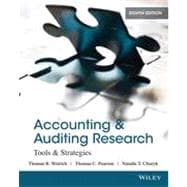
Note: Supplemental materials are not guaranteed with Rental or Used book purchases.
Purchase Benefits
What is included with this book?
Preface
About the Authors
Chapter 1 Introduction to Applied Professional Research
Learning Objectives
What is Research?
Research Questions
Nature of Professional Research
Critical Thinking and Effective Communication
Economic Consequences of Standards Setting
Role of Research in the Accounting Firm
Research and the CPA Exam
Overview of the Research Process
Step One: Identify the Relevant Facts and Issues
Step Two: Collect the Evidence
Step Three: Analyze the Results and Identify the Alternatives
Step Four: Develop a Conclusion
Step Five: Communicate the Results
Summary
Discussion Questions
Appendix
Chapter 2 Critical Thinking and Effective Writing Skills for the Professional Accountant
Learning Objectives
Critical Thinking Skills
Levels of Thinking
Universal Elements of Reasoning
An Example of Using Critical Thinking Skills
Effective Writing Skills
Writing as a Process
Punctuation Primer
Improved Writing Skills Required
Active Voice
Short Sentences
Definite, Concrete, Everyday Language
Tabular Presentation
Limited Jargon and Technical Terms
No Multiple Negatives
Elements of Plain English
Writing Effective E-mails and Letters
Writing Memos to the File
Summary
Discussion Questions
Exercises
Chapter 3 The Environment of Accounting Research
Learning Objectives
The Accounting Environment
The SEC and the Standard-Setting Environment
Rules-Based Versus Principles-Based Accounting Standards
Financial Accounting Standards Board
FASB Strives to Simplify Standards
Content of Authorities
FASB Due Process
FASB Conceptual Framework Project
Statements of Financial Accounting Concepts Nos. 1–8
American Institute of Certified Public Accountants (AICPA)
Governmental Accounting Standards Board
Other Organizations Influencing Standard Setting
U.S. Generally Accepted Accounting Principles (U.S. GAAP)
The FASB Accounting Standards Codification
Using Authoritative Support
Reading an Authoritative Pronouncement
Accounting Choices Have Economic Consequences
Summary
Discussion Questions
Exercises
Chapter 4 Financial Accounting Research Tools
Learning Objectives
Accounting Research Online
Database Research Strategies
Step One: Define the Information Needed
Step Two: Determine the Sources to Search
Step Three: Use Appropriate Search Methods
Step Four: View the Results and Manage the Information
Step Five: Communicate the Search Results
FASB Accounting Standards Codification Research System
The Research Process
Locating U.S. GAAP Using the Codification
Examples Using the Codification
SEC Accounting for Public Companies
SEC Regulations and Sources
The SEC’s Published Views and Interpretations
SEC Staff Policy
Accessing SEC Filings and Regulations
Cases to Practice Accounting Research
Summary
Discussion Questions
Appendix: CPA Exam—Financial Accounting Simulations
Chapter 5 The Environment of International Research
Learning Objectives
International Accounting Environment
International Accounting Standards Board (IASB)
IASB Authorities
IASB Due Process
Interpretations Committee Due Process
IASB’s Conceptual Framework
Principle-Based Accounting Standards
IFRS Funding, Regulation, and Enforcement
International Financial Reporting Standards (IFRS) Research
IFRS Hierarchy
Electronic International Financial Reporting Standards (eIFRS)
Summary
Discussion Questions
Exercises
Chapter 6 Other Research Databases and Tools
Learning Objectives
Other Database Research Strategies
Step One: Define the Information Needed
Step Two: Determine the Sources to Search
Step Three: Use Search Techniques and Tools
Step Four: View the Results and Manage the Information
U.S. Accounting Research Tools
Commercial Accounting Databases
AICPA’s Reference Sources
U.S. Government Accounting Databases
GASB’s Government Accounting Research System (GARS)
Federal Accounting Standards Advisory Board Handbook of Authorities
Financial Research Databases
Standard & Poor’s (S&P) NewAdvantage
Mergent Online
Thomson Research
Other Financial Databases and Sources
Financial Research Challenges
Business Research Databases and Tools
Article Index Databases
International Business Sources
Statistical Sources
Specialized Research
Massive Legal Research Databases
LexisNexis
LexisNexis Academic
Other Legal Databases
Summary
Discussion Questions
Exercises
Appendix: Web Site Addresses
Chapter 7 Tax Research for Compliance and Tax Planning
Learning Objectives
Tax Research Goals
Tax Research Challenges
Tax Research Databases
Checkpoint
Primary Tax Authorities
The Code
Administrative Authorities (Particularly Treasury Regulations)
Steps in Conducting Tax Research
Step One: Investigate the Facts and Identify the Issues
Step Two: Collect the Appropriate Authorities
Step Three: Analyze the Research
Step Four: Develop the Reasoning and Conclusion
Professional Standards for Tax Services
Summary
Discussion Questions
Chapter 8 Assurance Services and Auditing Research
Learning Objectives
Assurance Services
Consulting Services and Standards
Attestation Services and Standards
Auditing Standard-Setting Environment
Auditing Standard-Setting Process
Auditing Standards Board (ASB)
Public Company Accounting Oversight Board (PCAOB)
International Auditing & Assurance Standards Board (IAASB)
AICPA Online Professional Library
AICPA Code of Professional Conduct
Auditing Standards in the Public Sector
Compilation and Review Services
Role of Judgment and Professional Skepticism in Accounting and Auditing
Economic Consequences
Summary
Discussion Questions
Exercises
Appendix: CPA Exam Audit Simulation
Chapter 9 Redefining the Research Process
Learning Objectives
Method of Conducting Research
Step One: Identify the Issues or Problems
Identify the Preliminary Problem
Analyze the Problem
Refine the Problem Statement
Step Two: Collect the Evidence
Identify the Keywords for Research
Locate and Examine the Relevant Authorities
Review Insightful Nonauthoritative Sources
Step Three: Analyze the Results and Identify Alternatives
Step Four: Develop a Conclusion
Step Five: Communicate the Results
Lessons Learned for Professional Practice
Remain Current in Knowledge and Skills
International Complexities in Practice
Skills for the CPA and Similar Exams
Summary
Discussion Questions
Exercises
Appendix A
Appendix B
Chapter 10 Forensic Accounting Research
Learning Objectives
Definition of Fraud
Types of Fraud
The Fraud Triangle
Overview of a Financial Statement Fraud Examination
Step One: Identify the Issue and Plan the Investigation
Step Two: Gather the Evidence and Complete the Investigation Phase
Step Three: Evaluate the Evidence
Step Four: Report Findings to Management or Legal Counsel
Business Investigations
Computer Technology in Fraud Investigations
Data-Mining Software
Public Databases
The Internet
Fraud Investigation Regulations
Summary
Discussion Questions
Exercises
The New copy of this book will include any supplemental materials advertised. Please check the title of the book to determine if it should include any access cards, study guides, lab manuals, CDs, etc.
The Used, Rental and eBook copies of this book are not guaranteed to include any supplemental materials. Typically, only the book itself is included. This is true even if the title states it includes any access cards, study guides, lab manuals, CDs, etc.